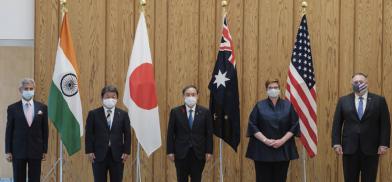Quad should define the new global narrative in checking China's rise
India too would appear to be finally moving towards a more ‘aligned’ foreign policy in response to a militaristic and aggressive China and its puppet ally Pakistan, both implacably opposed to her rise, writes Amb Bhaswati Mukherjee (retd) for South Asia Monitor

Even before COVID-19 hit an unsuspecting world, fissures in the existing power balance were manifest. A determined and crafty Chinese President Xi Jinping was plotting the central positioning of the ‘Middle Kingdom’ at the expense of the existing world order, led by the USA.
For Xi, China’s hegemony would cover major portions of South and South East Asia and Africa. For China’s neighbourhood, friendly relations would depend on the extent of subservience that a potentially vassal state can offer. Its best example is Pakistan.
The threat was not just land-based but also from the sea. China considers itself now as a major maritime and
continental power. It's aggressive posturing in the South China Sea was an ominous indicator of the threat it poses, by land to India and by sea to the Western Alliance, ASEAN (Association of Southeast Asian Nations), and India.
The response from the west was not united. In particular, confusing and contradictory signals from the EU, with a hastily adopted China EU FTA (free trade agreement) in the last days of December 20 under Angela Merkel’s German Presidency, reinforced the perception of the world’s biggest economic grouping ignoring China’s threats in a naive quest for joint economic bounty.
Quad – a realistic response to China
It is the Quad, consisting of Australia, Japan, India, and the USA, with its commitment to a rules-based order that represents the first realistic response to China’s aggression by sea and land, especially in the Indo- Pacific. The Quad realized that the Indo-Pacific was it's new strategic imperative. It is marked by a precarious geometry of fault-lines and historic strategic mistrust. It was becoming the centre of China’s efforts to establish its dominance as a maritime power.
For India, facing the brunt of Xi’s policy of ‘nibbling away’ at her territory, the stakes are very high. The process of disengagement in Eastern Ladakh after a 10-month standoff carries no assurance of a change of heart by China.
Hardnosed strategists in the Ministry of External Affairs (MEA) and Ministry of Defence (MoD) are of the view that pressure by the US and the likelihood of the Quad becoming a military formation, along with loss of face by the People's Liberation Army (PLA) in the Kailash Range, convinced Xi of the need to retreat and re-group.
This is a lull and not a cessation of hostilities by China. Peace overtures by Pakistan should be seen in the same light.
To India, the Quad represents a strategic alliance, corresponding to the challenges of the times. When India engages with the Quad, it enhances its strategic autonomy vis-à-vis China. As the balance of power in the Indo-Pacific dramatically shifts, India’s assessment of this balance and its actions will be crucial to preserving its strategic balance in this vortex of shifting power balances in the emerging order.
China is bitterly opposed to the Quad and has persuaded Russian Federation that it is an anti-Russian grouping also. China’s Foreign Minister Wang Yi had publicly stated that the Quad was an Asian NATO.
India’s intention to move further on the Quad was clear from the statement of Foreign Minister Dr. S. Jaishankar on November 29, 2020: “The concept of Indo-Pacific is a rejection of the spheres of influence and a reiteration that the world cannot be frozen for the benefit of a few even if that is the case with the United Nations….The Indo-Pacific was an indication of a future, not a throwback to the past. Only those harbouring a Cold War mindset will see such intentions. It was also a reminder of the importance of multilateralism. And that, in turn, requires adherence to a rule-based global order.”
China had been optimistic that the Joe Biden Administration would reverse Trump’s Indo-Pacific policy and revert to a more traditional American foreign policy with cooperation rather than containment of China. President Biden moved swiftly to assert US priorities and global leadership role.
Re-constituted US National Security Council
The composition of the re-constituted US National Security Council has a strong focus on the Indo-Pacific with 20 experts who have advocated a tough stance on China. Led by Indo-Pacific Coordinator Kurt Campbell, the division at the National Security Council will combine the directorate for Asian affairs - which traditionally covers China, Japan, the Koreas, Southeast Asia, and Australia - and the South Asia directorate which oversees India.
National Security Council (NSC) spokesperson Emily Horne said publicly: “Kurt Campbell's Indo-Pacific team will be the largest regional NSC directorate, a sign of how this NSC is prioritizing China and broader Indo-Pacific policy issues."
This re-constitution of the NSC was followed by the third meeting of Quad foreign ministers, the 1st in the Biden Presidency, on February 18, 2021. For US Secretary of State Anthony Blinken, it was his first encounter, though virtual, with his other Quad colleagues.
Separate press releases by the four foreign offices reflected a clear convergence of views on key issues. Blinken tweeted: “I look forward to advancing our vision of a free and open Indo Pacific.” A statement by the US State Department noted that the foreign ministers would meet annually while the senior officials would meet more often.
The MEA noted significantly that there was a reiteration of the “common vision for a free, open and inclusive Indo-Pacific region, with clear support for ASEAN cohesion and centrality. The Indo-Pacific concept had gathered growing international support, including in Europe.”
Should the Quad evolve into a formal alliance, as is hoped, it would be a repudiation of the power grouping established after World War II, symbolised in the Permanent Membership of the Security Council. Three of its members, Australia, Japan, and India, remain outside this outdated power structure. They belong to other important groupings outside the P-5, including G20, a possible expanded G-7, and a possible D-10, as suggested by UK Prime Minister Boris Johnson.
The success of the emerging world order would also depend on the US recognizing that in a multi-polar world, America needed more plurilateral arrangements. The USA must also acknowledge that the new challenges cannot be responded to by NATO, because of its membership which includes Turkey. Turkey’s repositioning in an emerging anti-Western alliance led by China is a formidable challenge to NATO itself.
India too would appear to be finally moving towards a more ‘aligned’ foreign policy in response to a militaristic and aggressive China and its puppet ally Pakistan, both implacably opposed to her rise. These changes in foreign policy came with the realization that India is not just a continental power but a great maritime power.
India takes on larger global role
India, from perpetually being a cautious power, is seemingly ready to take on a larger global role by being more nimble in addressing global challenges.
One could well conclude that the new global narrative on security and the continuation of the present world
order would depend on how the Quad, as a new power grouping, responds to Xi’s China.
The US and India are the central powers in the Quad. There really is no other choice. The new order, rule-based and multilateral, must check China’s rise. Otherwise, the 21st century would belong to China, with devastating consequences to international peace and security.
(The writer is a former Indian ambassador and an expert on European affairs. The views are personal)










Post a Comment